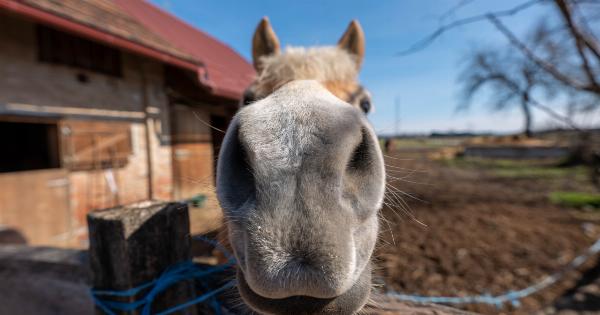A stuffy nose, also known as nasal congestion, can be quite bothersome and can interfere with daily activities. It occurs when the nasal passages become blocked due to swelling of the blood vessels in the lining of the nose.
This can be caused by various factors, ranging from allergies to infections. In this article, we will explore some common causes of a stuffy nose and effective ways to treat it.
Allergies
Allergies are a common cause of nasal congestion. When you have an allergic reaction, your immune system reacts to a particular substance known as an allergen. This can be pollen, dust mites, pet dander, or certain food items.
In response to the allergen, the body releases chemicals, such as histamine, which cause the blood vessels in the nasal passages to become inflamed and result in a stuffy nose.
Sinus Infections
Sinus infections, also called sinusitis, can cause a stuffy nose. It occurs when the sinus cavities, which are located behind the forehead, cheeks, and eyes, become inflamed and filled with fluid.
This can be due to a viral, bacterial, or fungal infection. Along with nasal congestion, sinus infections can cause facial pain, headache, and thick nasal discharge.
Common Cold
A common cold is one of the most prevalent causes of a stuffy nose. It is a viral infection that affects the upper respiratory system, including the nose and throat.
Common cold symptoms can include nasal congestion, sneezing, sore throat, cough, and mild body aches. The stuffy nose typically improves within a week as the body fights off the virus.
Deviated Septum
A deviated septum can also contribute to nasal congestion. The septum is the wall of bone and cartilage that separates the two nasal passages.
In some individuals, the septum is not perfectly centered, causing one nasal passage to be smaller than the other. This can lead to a stuffy nose on one side, making it difficult to breathe through one nostril.
Nasal Polyps
Nasal polyps are noncancerous growths that can develop in the lining of the nasal passages or sinuses. They are often associated with chronic inflammation of the nasal mucosa.
Nasal polyps can cause persistent nasal congestion, reduced sense of smell, facial pain or pressure, and postnasal drip. In some cases, surgical removal may be necessary to alleviate the symptoms.
Pregnancy
During pregnancy, hormonal changes can lead to nasal congestion. Increased blood flow to the nasal passages can cause them to swell, resulting in a stuffy nose.
This condition is referred to as “pregnancy rhinitis.” It is a common occurrence during pregnancy and usually resolves on its own after childbirth.
Exposure to Irritants
Exposure to certain irritants can cause nasal congestion. These irritants may include tobacco smoke, strong odors, chemicals, and air pollution. The irritation can lead to inflammation of the nasal passages and a stuffy nose.
Avoiding exposure to these irritants or using protective measures, such as wearing a mask, can help prevent nasal congestion.
Overuse of Nasal Decongestant Sprays
Nasal decongestant sprays can provide temporary relief from nasal congestion. However, long-term use of these sprays can actually worsen the condition.
Overuse can lead to a condition known as “rebound congestion,” where the nasal passages become dependent on the spray to stay open. It is best to limit the use of nasal decongestant sprays to only a few days.
Treatment Options for a Stuffy Nose
When faced with a stuffy nose, there are various treatment options available that can provide relief. Here are some effective ways to alleviate nasal congestion:.
1. Saline Nasal Irrigation
Saline nasal irrigation involves flushing the nasal passages with a saltwater solution. This helps to moisturize the nasal passages and remove allergens, mucus, and irritants. It can be done using a neti pot, squeeze bottle, or nasal spray.
Saline nasal irrigation is generally safe and can be used daily for ongoing relief.
2. Steam Inhalation
Inhaling steam can help to loosen mucus and relieve nasal congestion. You can create steam by filling a bowl with hot water, placing a towel over your head, and breathing in the steam.
Adding essential oils like eucalyptus or peppermint can provide additional benefits. Be cautious to avoid burns from the hot water or steam.
3. Nasal Decongestant Sprays
Over-the-counter nasal decongestant sprays can provide temporary relief from nasal congestion. They work by constricting the blood vessels in the nasal passages, reducing inflammation, and opening up the airways.
However, prolonged use should be avoided as it can lead to rebound congestion.
4. Antihistamines
If allergies are the cause of your stuffy nose, antihistamines can be effective in reducing the allergic response. They block the effects of histamine, thereby reducing inflammation and alleviating nasal congestion.
Antihistamines are available in oral tablets, capsules, and liquid forms, as well as nasal sprays.
5. Nasal Steroid Sprays
Nasal steroid sprays are highly effective in reducing nasal inflammation and providing long-term relief from nasal congestion caused by allergies. They work by decreasing inflammation in the nasal passages and reducing the production of mucus.
Nasal steroid sprays are available over-the-counter or through prescription.
6. Avoid Allergens
If your nasal congestion is due to allergies, avoiding the allergens can help prevent and alleviate symptoms.
For instance, if you are allergic to pollen, try to stay indoors on days with high pollen counts or use an air purifier to reduce allergens in your living space. Dust mites can be minimized by using dust-proof covers on pillows and mattresses, washing bedding frequently, and keeping rooms clean and well-ventilated.
7. Stay Hydrated
Drinking plenty of fluids can help to thin the mucus and reduce nasal congestion. Opt for water, herbal teas, clear broths, and warm soups to stay hydrated.
Avoid excessive consumption of caffeinated or alcoholic beverages as they can dehydrate the body and worsen nasal congestion.
8. Elevate Your Head
Keeping your head elevated while sleeping can help reduce nasal congestion. Use an extra pillow or raise the head of your bed slightly to promote better drainage and minimize swelling of the nasal passages.
This can make breathing easier and alleviate the feeling of a stuffy nose.
9. Humidify the Air
Dry air can exacerbate nasal congestion. Use a humidifier or vaporizer to add moisture to the air, especially during dry seasons or in heated environments. This can help keep the nasal passages moist and relieve congestion.
Ensure proper cleaning of the humidifier to prevent the growth of mold or bacteria.
10. Seek Medical Advice
If your stuffy nose persists for an extended period, is accompanied by severe facial pain, or is interfering with your daily activities, it is advisable to seek medical advice.
A healthcare professional can determine the underlying cause of your nasal congestion and provide appropriate treatment options.


























